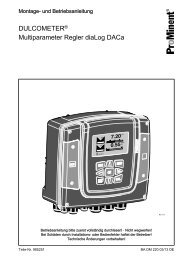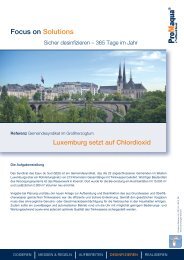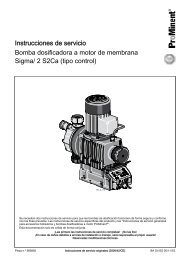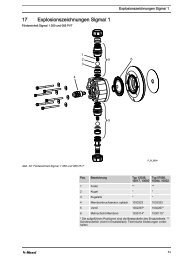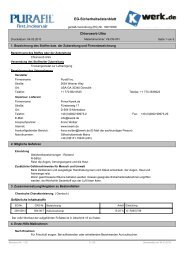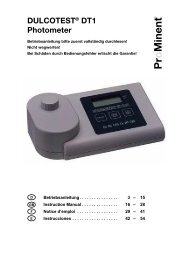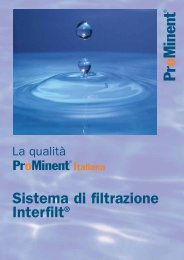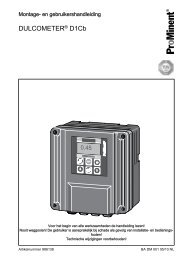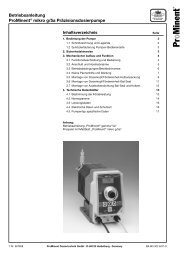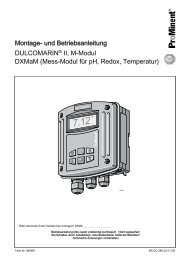Pr o Minent
Pr o Minent
Pr o Minent
Create successful ePaper yourself
Turn your PDF publications into a flip-book with our unique Google optimized e-Paper software.
9 Technical TermsAdditive basic load: This results in the fact that the controller always generates a manipulated valuecorresponding to the additive basic load. This load may only be reset to 0 using thestop button. This function should not be activated when using PI or PID controllers.Calibration: By calibrating (adjusting), the measuring value readout will be adjusted to the actualprobe signal. Without calibration, a correct measurement is not possible. A calibrationshould be performed regularly (depending on application). If the DULCOMETER ® D2Coperates with automatic or manual temperature correction, a Pt 100 must beimmersed in the buffer solution or the buffer temperatures entered manually.Control parameter: The control parameters (xp, Ti, Td) determine the control characteristic (PID).Correction value:Dead zone:The signal of the pH probes (e.g. 59 mV/pH at 25 °C) is influenced by temperature.High temperatures increase the signal while low temperatures reduce the signal. Theresulting measurement errors can be compensated for by way of temperaturecorrection. As a rule, no correction is necessary for measurements conducted withinthe range around pH 7. However, if the measuring range is further away from pH 7,automatic temperature correction via Pt 100 should be implemented in the case offluctuating temperatures. Manual temperature correction can be used if temperaturesare constant.2 setpoints can be specified in the "control with dead zone" setting. If the measuredvalue is outside the setpoint range defined in this way, the corresponding actuator isactivated. If the measured values are within the setpoint range, the controllerfunctions as if the setpoint were reached. In the case of a P-controller a controlledvariable is then no longer produced. In the case of PI-controllers, the last controlledvariable is retained.Manual control: In this setting, the controller produces a controlled variable corresponding to the entry.It is retained up to the next change. It is independent of the measured variable and theset control parameters. This setting can be used for determining the time response (e.g.dead time...) of the controlled system.Metering direction: This value determines in which direction the controller is active. In case of themetering direction "acid", the controller generates a manipulated value when thespecified value for pH is exceeded.Regulated value:Relay:Solenoid valve:Set point:Slope:The regulated value is the value (e.g. frequency, mA signal) the controller sends to thefinal controlling element, e.g. metering pump to reach again the set point.The relay (alarm, limit relay) switches when the corresponding prerequisites(e.g. alarm condition, limit violation) are given. The relay function can be set eitheras make contact (active closed) or break contact (active open). The relay may bereset pressing the stop button.Activation of solenoid valves (motor-driven pumps) is defined by the cycle time andthe minimum on-state interval (minimum time) (pulse length control). The on-stateinterval always corresponds to at least the minimum time. However, it is increased upto the cycle time at a maximum depending on the control deviation and the controlresponse. The cycle time itself defines the maximum possible on-state operations.For instance, an actuator is switched on a maximum of 60 times per hour when thecycle time is at 60 seconds. The minimum time defines the minimum on-state intervalduration. It should be selected as small as possible while, however, ensuring thatmetering is still possible within this time.The set point is the value which is to be continuously maintained stable throughout theprocess via controlling.The slope of pH probes should always be >50 (better >55) mV/pH.21




